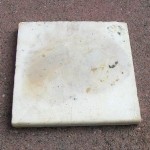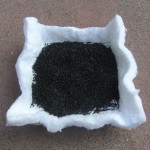New Firing Method
Since my last posting I have been working on a firing method that will be cleaner, cheaper, and shorter. I’ve finally found one. This method does not require a stainless steel box, uses a lot less carbon, requires no vacuuming, and leaves the kiln perfectly clean after firing. The kiln can be either cold or hot both before and after firing, overall firing time is shorter, and firing temperature is lower. [Edit on 2/1/2010, 8:10 a.m. PST: I’d like to clarify that as of now, I have only tested this method with my Quick-fire clay. Thanks to readers who asked me to clarify this.] So here goes:
[Edit on 2/3/2010, 4:00 p.m. PST: STOP! These instructions have now been updated, and the latest version can be found here.]
1. Place your ceramic/fiber kiln shelf on posts to position it high in the kiln.
2. Fold a a fiber blanket into a “box.”
The fiber blanket can be re-used. It is quite inexpensive to buy it in rolls from glass fusing suppliers; you can then cut it with scissors to your desired dimensions. The one I bought was 1 inch thick, and I separated it into two layers a half-inch thick.
You can also purchase a rigidizer from the same source (these are normally used to make slumping molds for glass fusing). This will stabilize the shape of your box.
3. Line the inside of the blanket “box” with a ½” layer of carbon.
4. Arrange your pieces on the carbon bed. As usual, avoid the center.
5. Cover the pieces with another ½” inch layer of carbon.
6. Cover the carbon with another piece of blanket, creating a “sandwich.”
Firing Schedule
You can start the firing in either a cold or a hot kiln.
Top loader brick kiln: ramp at full speed to 1450°F/788°C
Front loader muffle kiln: ramp at full speed to 1530°F/832°C
(You may find that this temperature is too high for bronze. If it is, flat bronze pieces wil warp some. You can either hammer them down after firing or lower the temperature.)
Hold for 1:00 hour.
You can take the pieces out of the kiln while still hot or wait until they cool down. Overnight firing works fine. If you take them out hot, use heat-protective gloves. The sandwiched part is actually on fire!
After firing, most of the carbon turns into ash. Pick up the fiber “box” from both ends and lift it out of the kiln. The kiln will be perfectly clean.
Almost all of the carbon will have turned into ash, including the bottom layer. Just throw it away. To retreive your pieces you can pour it hot through a sieve into a metal container.
This schedule works best with bronze (even with very thick pieces), with mixed pieces, and with average sized pieces of copper. The bronze circle on the right is ¾” in diameter, ¼” in thickness.
[
I am now working on a schedule for thick and/or large pieces of copper, starting with the following options:
- Hold for 2 hours, or
- Hold at 1000°F/538°C for 0:30 minutes to 1:00 hour before proceeding to the goal temperature, or
- Raise the temperature. Copper can be fired as high as 1770°F/965°C (as in the schedule “Hot Firing” in the instruction manual for Quick-fire clay).
As soon as I have reliable results for copper firing, I will post them and make the necessary changes in the instruction manuals.








January 31st, 2010 at 6:03 pm
I was JUST thinking about emailing you to see how this was coming along…Cant wait to try it out! Thanks Hadar!
January 31st, 2010 at 6:48 pm
One hour? WOW, Hadar!
January 31st, 2010 at 7:40 pm
Thanks for the tips!
January 31st, 2010 at 7:48 pm
Hi Hadar, well, it gets better and better! What great ideas you have! Does this firing work also for the “old” bronze/ copper?
January 31st, 2010 at 9:02 pm
No, Ingrid, it only works with Quick-fire clay.
February 1st, 2010 at 6:43 am
Great.
I use a product that I think you should try instead of the fiber blanket to make the “box” and “lid.” It is made of alumina silica. I use it in many ways. I torch fire on in, ue it to cast glass into it, as a kiln shelf etc. It reflects the heat like the fiber blanket and holds the heat inside.
It carves very esily.
I would make a box out of 3 pieces of the alumina silica board. One for the top, one for the lid. Cut out a rectanular cavity for the box sides. Assemble your box.. solid bottom (or in my case no bottom because my kiln shelf is one of these products) the wall layer, load with carbon and your pieces, then put the top on.
This would be clean, neat and lsts forever. (or a very long time, I haven’t had one degrade yet … for years.) 🙂 Nancy
February 1st, 2010 at 11:16 am
This looks really good. Looks like I am back in the bronze business! Thank you Hadar!
Catherine
February 1st, 2010 at 12:06 pm
Sounds good, but…. How does the lower cost of the shorter firing time compare to the increased cost of the burned up carbon? Thanks for all your testing!
February 1st, 2010 at 12:41 pm
Mary Ellin,
First, not much more carbon is burnt out since you are using less of it in the first place. Second, carbon can be bought in 28 LB units for $60. But don’t tell anybody I said so 🙂
February 1st, 2010 at 5:16 pm
As always, THANK YOU for always looking for a better solution, and then sharing the information! This is fabulous!
-amy in Ohio
February 2nd, 2010 at 2:43 pm
As someone who is new to copper, bronze, and steel I am so grateful that you are doing the experimenting and I can benefit from your endeavors. Thanks. O.